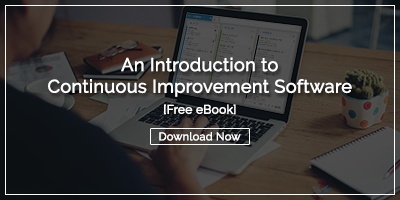 Discounting the time we sleep, most of us spend more than 50% of our time working. While working, many of us think of ideas about ways to improve that work. Often, it’s not generating ideas that we struggle with, but rather, we have difficulty finding a productive way to share these ideas and spread continuous improvement.
Discounting the time we sleep, most of us spend more than 50% of our time working. While working, many of us think of ideas about ways to improve that work. Often, it’s not generating ideas that we struggle with, but rather, we have difficulty finding a productive way to share these ideas and spread continuous improvement.
Some organizations try to encourage people to spread improvement by implementing a suggestion box methodology, but these are rarely successful. In modern companies with successful cultures of innovation and improvement, the traditional suggestion box is abandoned in favor of idea software that provides a platform for cross-functional collaboration.
There are two main types of Idea Software available:
-
Ideation Software
Crowd sourcing and community voting on new product ideas. Organizations using Ideation Software are likely to implement 2% or fewer of ideas, as these solutions are looking for the next big thing.
-
Continuous Improvement Software
Enabling small teams to make incremental improvement on their immediate work environment (which may or may not include product changes and/or innovations). Organizations implementing this successfully are able to make over 80% of suggested improvements.
It is important when choosing idea software that attention is given to what issue is being addressed. Are we looking for the next big thing, or trying to empower every employee by implementing a collaboration platform that supports a culture of continuous improvement?
More and more business leaders are realizing that using continuous improvement software results in more innovative ideas and daily improvements than does ideation software. The cumulative impact of improvement ideas has a significant impact on key business metrics from safety and quality to revenue and cost savings. Engaging everyone in the process and implementing a majority of ideas is the surest route to a stronger, more agile, sustainable company.
The continuous improvement strain of idea software is growing in popularity because:
- Employees Have Great Ideas
Traditionally, the burden of solving company problems with innovative ideas and process improvements falls squarely on the shoulders of executive leaders. Continuous improvement organizations realize that this is the wrong approach to solving problems and improving processes. That’s why they invite employees to make small, incremental, daily improvements in their own work. A widespread culture of continuous improvement engages the people who are closest to customers, production, spending, and service often know exactly which processes need repair, which functions need more resources, and what unnecessary baggage can be jettisoned. Idea software gives leaders a tool for asking them.
- People Love Implementing Their Own Ideas
Leaders talk a lot about employee engagement, but often fail to use the best tool for promoting it. Continuous improvement idea software empowers employees to suggest, analyze, implement, and assess the results of their own ideas, which is a great way to boost engagement, personal investment, and ultimately, compliance with new procedures and processes.
- An Idea Without Structure Is Just A Dream
Ideas are great, but without a structure for documenting, assessing, executing, and evaluating them, they are as useful as a daydream. Idea software supports the entire process from brainstorming through determining the ROI of continuous improvement. Structured improvement management is an essential part of the commitment to finding and acting upon the best inspirations your team can produce.
- We All Get Busy
It is easy to lose focus on opportunities for improvement when you are too busy trying to make broken process work and win the daily battle to put out fires. Idea software helps individuals and managers stay in the loop with reports, alerts, and active notifications that help make sure improving the work remains as important as doing the work.
- Achievement Should Be Recognized Early and Often
Employees making daily continuous improvements should be recognized for their efforts. Recognition goes a long way to boosting employee morale and is the best way to ensure more participation in continuous improvement - both by the person being recognized, and by others witnessing the praise earned through continuous improvement. It starts a cycle of achievement and its impact should not be underestimated.
- Continuous Improvement is a Team Sport
Continuous improvement has the greatest impact when cross functional teams are able to collaborate and improvements are shared throughout the organization for greater adoption. Idea software makes it easy for teams to work together regardless of their location, shift, or job function.
- If it Takes Too Long to Implement Ideas, They’ll Get Lost
One of the most important things leaders should do to promote a culture of continuous improvement is to respond quickly to engagement, empowering employees to find something to implement for every opportunity for improvement they identify. Continuous improvement idea software has a variety of features that push ideas through to implementation, ensuring that the work doesn’t stall and ideas are not lost.
Learn more about continuous improvement software in this free eBook:

 Discounting the time we sleep, most of us spend more than 50% of our time working. While working, many of us think of ideas about ways to improve that work. Often, it’s not generating ideas that we struggle with, but rather, we have difficulty finding a productive way to share these ideas and spread continuous improvement.
Discounting the time we sleep, most of us spend more than 50% of our time working. While working, many of us think of ideas about ways to improve that work. Often, it’s not generating ideas that we struggle with, but rather, we have difficulty finding a productive way to share these ideas and spread continuous improvement.